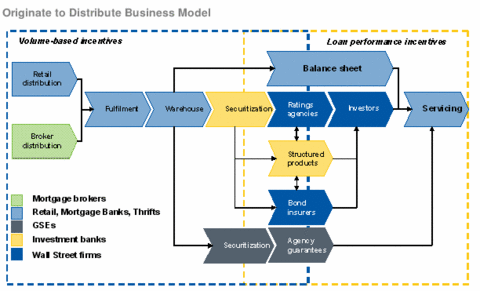
Research and consulting firm Celent released a study yesterday titled, “Pathology of the US Mortgage Crisis,” which examines the evolution of the credit crunch from its humble beginnings as a U.S. subprime mortgage problem to the subsequent global liquidity crisis that ensued.
The Boston-based firm noted that the global credit market saw a “flight of uncertainty” over the past nine months that led to billions in associated write-downs.
It also led to the fall of investment banking giant Bear Stearns, and multiple emergency rate cuts by the Fed.
Not to mention scores of layoffs and lender closures throughout the United States, including the collapse of former #1 mortgage lender Countrywide, Greenpoint, NovaStar, and many other big names.
Shift from Originate and Hold to Originate to Distribute
Celent noted that a big factor behind the mortgage crisis was the shift from an “originate and hold” mentality to an “originate to distribute” model.
In the past, banks would offer loans to their customers and hold them in their portfolios until they were paid off.
This meant they cared an awful lot about loan quality, and took the time to underwrite loans properly. Ditto for the types of loans they offered, and the risk they took.
But things changed in the early 2000s, where it turned into a veritable game of hot potato as loans were sliced and diced, packaged and sold.
Essentially, most originating banks and mortgage lenders only held onto mortgages long enough to sell them off to investors, promoting a higher-risk environment for loan origination.
Under this system, mortgage brokers and originating banks had volume-based incentives that weakened underwriting standards.
Meanwhile, investment banks and Wall Street firms worked on loan performance incentives.
This disparity caused scores of low quality loans to funnel through the system and find their way into structured investments that eventually spoiled as home prices began to stagnate and fall, and mortgage defaults began to surge.
Bernanke Took Issue with Originate to Distribute Model
This isn’t the first time the originate to distribute model has been blamed for the mortgage crisis.
Fed Chief Ben Bernanke has called the system into question on numerous occasions.
He noted that a large number of high-cost mortgages were made by unregulated independent mortgage companies that sold nearly all of the mortgages they originated.
Simply put, once the loan was sold they didn’t care what happened. It could have fallen into foreclosure, but their hands were wiped clean of it.
Had the old model still been in place, the bank that originated the loan would be left holding the bag. And that may have led to them not making such loans in the first place!
Below is a great model from Celent that maps out the originate to distribute model, revealing the fragility of such a system.

(top photo: dreamsjung)
- UWM Launches Borrower-Paid Temporary Buydown for Refinances - July 17, 2025
- Firing Jerome Powell Won’t Benefit Mortgage Rates - July 16, 2025
- Here’s How Your Mortgage Payment Can Go Up Even If It’s Not an ARM - July 15, 2025
